Visit the art blog at thematicconversion.tumblr.com and the relog blog at evtrained.tumblr.com.
92 posts
04 Of 05 - Modern Compendium: Deity Family, Part 3 - Rumor Attic Bride
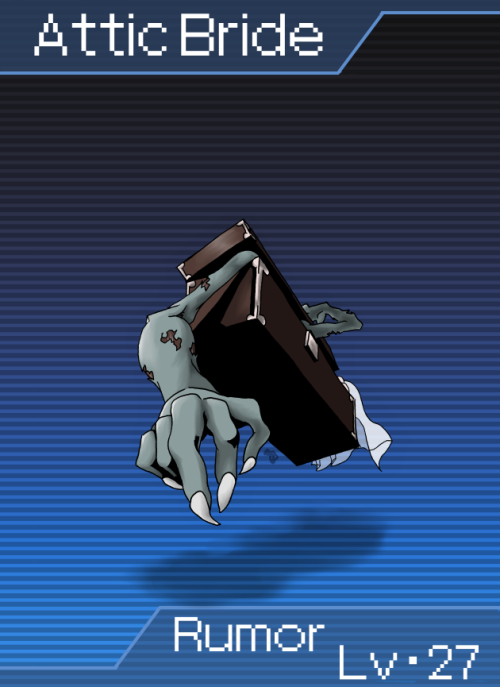
04 of 05 - Modern Compendium: Deity Family, Part 3 - Rumor Attic Bride
A popular and deceptively old urban legend, the story of the Bride in the Attic is one of those stories that gets told around campfires and on Halloween for chills, but not many people actually take it seriously.
The myth itself tells the story of a woman who, after many years of waiting and longing for a husband, fell in love and married the man of her dreams. After a fairy tale wedding, their friends and family treated them to a big house party with all the trimmings. Eventually someone suggested that they play some party games, and they started with Hide and Seek. The bride ran to the attic and hid in an old steamer trunk, and waited for someone to find her.
But no one ever did. The door to the attic had shut behind her, and the trunk had locked as it fell down on top of her. The wedding guests looked and looked, but it wasn’t until years and years later, when her widowed husband finally died, that anyone thought to look in the old trunk in the attic.
The story itself has a huge number of variations. Some versions have the husband as a sinister man who intended the bride to be locked in the attic, but he never gets his hands on her wealth because her vengeful spirit comes back to haunt him. Other versions have the husband himself finding the bride weeks or months later, as she begins to smell. Often a beating heart or spooky thumps on the ceiling are involved. But the most common alteration to the story is the city in which it happens; most people make sure the story takes place “just down the road” or “in a town just like this one” for maximum fireside spookies.
The Attic Bride fits easily into the Rumor family, but because it’s not a story that many people take very seriously, it’s not a particularly powerful demon. She is one of the few Rumors that is weak to Dark, though, so the Bride does have one unique thing to her credit.
For more info on this and every other demon in the Modern Compendium, have a look at our expanding Data File, right over (here.)
-
 xxglitterdalambxx liked this · 7 years ago
xxglitterdalambxx liked this · 7 years ago -
 kinemax liked this · 8 years ago
kinemax liked this · 8 years ago -
 worsethanmanyfairies liked this · 9 years ago
worsethanmanyfairies liked this · 9 years ago -
 khancrackers liked this · 9 years ago
khancrackers liked this · 9 years ago -
 khancrackers reblogged this · 9 years ago
khancrackers reblogged this · 9 years ago -
 esidisi liked this · 9 years ago
esidisi liked this · 9 years ago -
 thedrunkenminstrel reblogged this · 9 years ago
thedrunkenminstrel reblogged this · 9 years ago -
 turtlesworldofwhut liked this · 10 years ago
turtlesworldofwhut liked this · 10 years ago -
 abstractscarecrow reblogged this · 10 years ago
abstractscarecrow reblogged this · 10 years ago -
 abstractscarecrow liked this · 10 years ago
abstractscarecrow liked this · 10 years ago -
 whiskywiskian liked this · 10 years ago
whiskywiskian liked this · 10 years ago -
 bornbymidnight liked this · 10 years ago
bornbymidnight liked this · 10 years ago -
 nagabenang reblogged this · 10 years ago
nagabenang reblogged this · 10 years ago -
 xerozohar liked this · 10 years ago
xerozohar liked this · 10 years ago -
 historyclasses reblogged this · 10 years ago
historyclasses reblogged this · 10 years ago -
 yuber liked this · 10 years ago
yuber liked this · 10 years ago -
 cinemadoll liked this · 10 years ago
cinemadoll liked this · 10 years ago -
 vodka-drawsinski liked this · 10 years ago
vodka-drawsinski liked this · 10 years ago
More Posts from Historyclasses
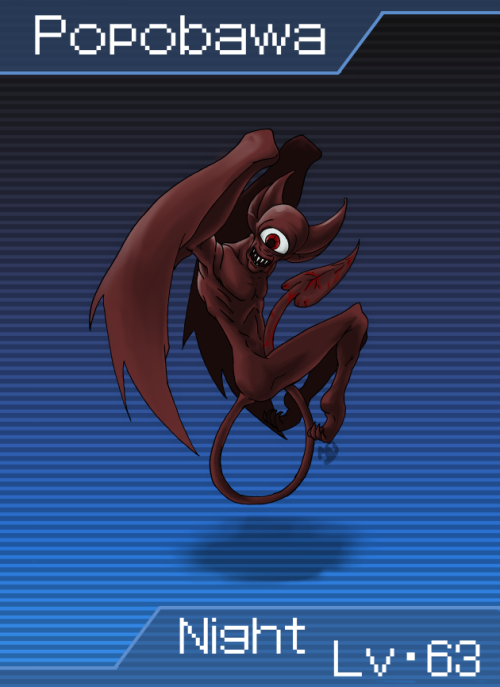
01 of 05 - Modern Compendium: Kishin Family, Part 5 - Night Popobawa
The mythology of Tanzania, an African country on the eastern coast of the continent, is a fascinating mix of ideas from Christianity, Islam, and myriad native folk religions. In modern times, these ideas have combined with politics and western Cryptozoology to create a truly novel demon known as the Popobawa.
The characteristics of the Popobawa are actually fairly similar to the Incubus of ancient Christian belief; a dark spirit, sometimes summoned by a sorcerer, to sexually assault people, usually women, in their sleep. However, the Popobawa is said to be a shapeshifter, only recognizeable by its bat-winged shadow – in fact the name “Popobawa” actually translates to “bat wing.” The creature is also said to be responsible for Poltergeist-like activity in homes and other physical attacks.
Popobawa reports have been responsible for several mass panics in Tanzania’s history, the most recent being in 2007. A couple of odd quirks in the creature’s mythology have helped this along; first, the idea that a Popobawa’s attacks can only be stopped by telling someone about them; and second, the fact that these reports multiply during election season. That’s right, there is a distinct possibility that we are looking at politically motivated fear mongering in the shape of a shadowy cycloptic man-bat. At least it’s more straightforward than color-coded terror charts, I guess.
At any rate, the Popobawa rates pretty high in the Night family, largely thanks to the heights of terror it inspires in populations that believe in it. Mechanically, it actually takes the place of the Succubus as the go-to Charm-based sex demon, though it is of course a bit more physically specialized.
For more info on this and every other demon in the Modern Compendium, have a look at the Data File, right over (here)!
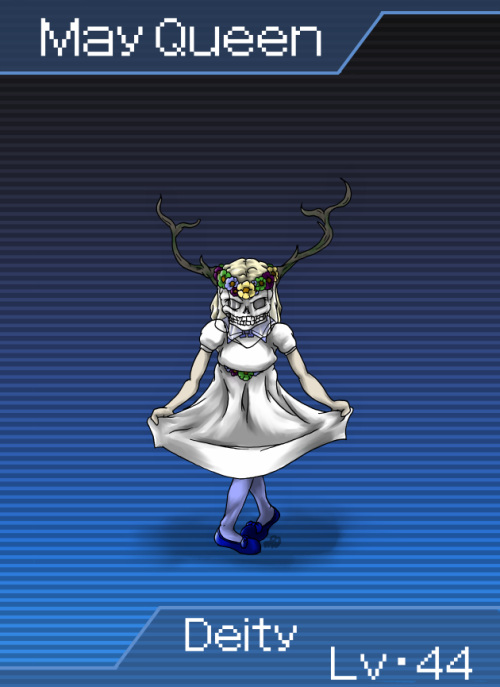
01 of 05 - Modern Compendium: Deity Family, Part 3 - Deity May Queen
The May Queen is a demon that shows the difference between what the basis of a myth actually is, and what people think it is. In modern times, the May Queen is a young woman elected to preside over May Day celebrations, to walk at the head of the parade and open the holiday dances. Historically, the May Queen is related to ancient tree worship, as this figure is closely connected with Maypoles, and the celebration of the return of spring. She wears a white dress to symbolize purity, and flowers in her hair to celebrate the renewal and rebirth of nature.
However, the May Queen is a myth whose historical fact has been largely overtaken by popular folklore. There is a popular and persistant urban legend that, somewhere in the murky depths of time, the May Queen was actually a sacrifice in waiting. Supposedly the people of English villages would select a young woman, give her all the best that they had to offer, and then, after May Day had passed, sacrifice her to some vicious pagan god. No doubt bloody stone altars and obsidian knives were involved.
However, and this is important to note, there is no evidence that I can find to actually back up the idea that this was ever done. As far as I can tell, someone somewhere just thought it sounded like a neat thing to tack on to the May Queen, and it stuck. Equally important is the fact that this gory and disturbing footnote to May Day is in fact very widely believed. No doubt the horror film The Wicker Man and its atrocious-bordering-on-comical 2006 remake are at least partially to blame, but whatever the cause, society at large has no trouble imagining a vicious start to this May Day tradition.
In any case, it is unfortunate for the May Queen that the version of any myth that matters for any practical purpose is the one that people actually believe in. And so the May Queen that gets into the Modern Compendium is the one with the disturbing backstory. The May Queen actually sits on the lower end of the Deity family, due in part to the dubious nature of belief in this version of her, but also because May Day celebrations aren’t hugely widespread outside of Europe and select parts of North America.
For more info on this and every other demon in the Modern Compendium, have a look at our Data File, right over (here).
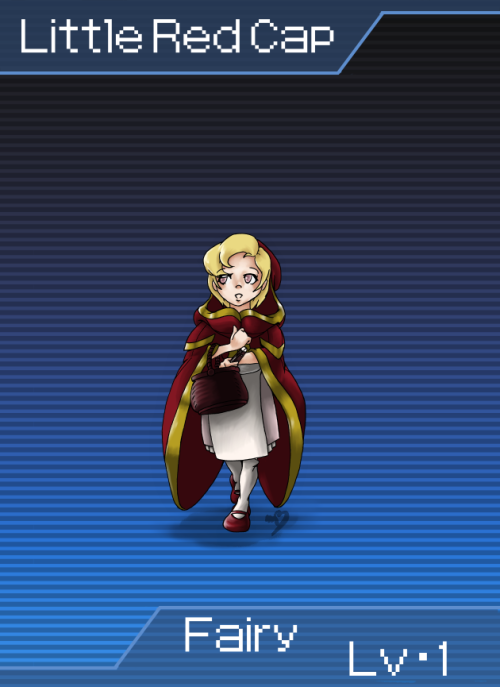
01 of 05 - Modern Compendium - Fairy Little Red Cap
This WAS going to be just a reblog to show I updated Little Red Cap’s artwork, but Tumblr doesn’t let you edit your stuff that way anymore. But that’s okay, I’m not really happy with how the old post reads anyway. So let’s do the whole thing over again! 8D
Anyway, Little Red Cap, better known as Red Riding Hood, is a perennially popular figure from fairy stories. The basic story is of course well known; a young girl is sent off to bring food to her ailing grandmother, but she has to go through the woods to get to grandma’s house. Along the way, a wolf stalks her, learns where she’s going, and gets to the house first, where she eats the girl’s grandmother. Little Red Riding Hood arrives at the house and engages in a battle of wits with the wolf, with the girl suspicious of her grandmother’s new appearance. There are a lot of variations on the ending, but usually the girl and her grandmother escape unscathed.
The popularity and extremely long history of Red Riding Hood’s story means there is a huge number of variations on the story. Sometimes the grandmother is eaten, sometimes she’s just imprisoned. Sometimes Red Riding Hood is saved by a woodcutter, and sometimes she outsmarts the beast. Heck, sometimes the wolf is a werewolf and LRRH actually has no cape on. Some scholars believe the story has origins as far back as the 10th century AD, so there may be as much as a thousand years worth of variation to work with here.
There is one major defining thing about the story that never changes. The underlying message of Little Red Riding Hood’s story is that there is a clear delineation between HERE, which is safe, and the scary, dangerous, wolf-infested THERE, and that wandering into it is not a good idea. I feel like that’s a good way to start a Shin Megami Tensei story - by announcing that you’ve just wandered into a very dangerous place that you should not be.
See, Little Red Cap is the Modern Compendium’s Pixie. She’s the first demon you meet, and she’s more or less your introduction to how demon allies work. She’s also capable of mass destruction should you level her high enough, learning Megidolaon at Lv. 65, which is actually a lower level than most other demons who get the skill. I admit this is equal parts a reference to the high-powered late game Pixie of Nocturne and my own love of cute things that are secretly capable of mass destruction.
For more info on this and every other demon in the Modern Compendium, have a look at our Data File, right over (here).
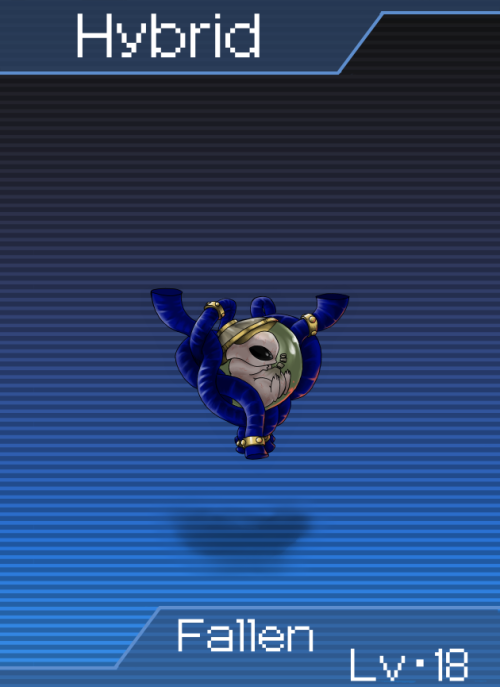
02 of 05 - Modern Compendium: Deity Family, Part 3 - Fallen Hybrid
Say hello to the first member of the Modern Compendium’s Fallen family! In Shin Megami Tensei games, the Fallen family is populated by angels that sided with Lucifer during his rebellion against and subsequent fall from Heaven. They are sort of the Chaos aligned equivalent of the Divine family, which is full of loyal, Law-based angels. In the Modern Compendium, the Divines are benevolent aliens from the mythology of UFO religions, and so the Fallen family shifts, too, becoming a family full of antagonistic aliens.
The stories around UFOs and aliens represent one of the richest veins of mythology in the modern mind, and one of the more popular tales people tell has to do with the Grey aliens. Often blamed for alien abductions, the Greys are said to perform elaborate and invasive procedures on the reproductive systems of the people they kidnap. These stories have led to theories that Greys are trying to create a race of Grey/Human hybrids, to infiltrate our culture and take over the world.
In fact, the actual purpose of this hybridization varies hugely depending on who is telling the story. Though many conspiracy theorists believe in the whole Greys-are-invading-our-genome-to-enslave-us idea, those who believe in more benevolent aliens tell stories of children with enhanced powers of empathy and kindness. This is best exemplified in this demon’s direct mirror in the Divine family - Indigo Children.
Anyway, I like to think the Hybrid would be roughly equivalent to Melchom or Orias; a low-level Fallen that serves as a common encounter in the early game. Although the Hybrid’s moveset kind of makes it closer to Gremlin, really.
For more info on this and every other demon in the Modern Compendium, have a look at our extensive and expanding Data File, right over (here).
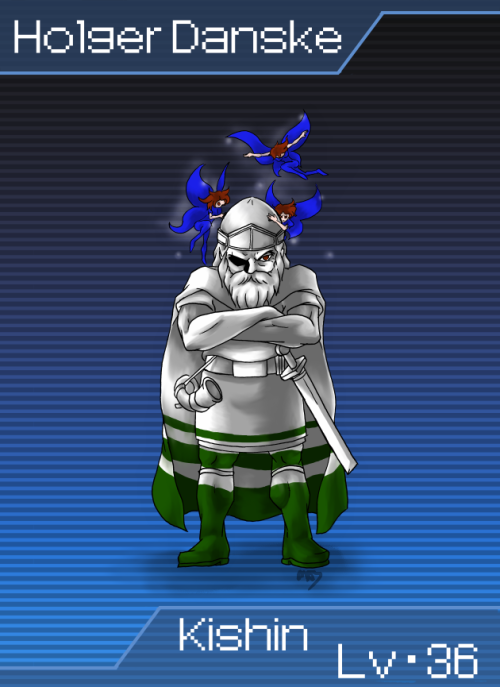
05 of 05 - Modern Compendium; Kishin Family, Part 3 - Kishin Holger Danske
A symbol of national pride and resilience, Holger Danske, also called Ogier the Dane, is about as pure a Kishin as you can find for the people of Denmark. He first entered the mythological lexicon of northern Europe in the 11th century, in the epic poem The Song of Roland. Holger appears as one of Charlemagne’s knights, leading a column of men against the enemy. Though he rarely stood out from other characters in the poems and stories he appeared in, Holger Danske quickly became a fan favorite of the Dutch people, leading him to appear in numerous stories up until the present day.
The most significant of these, at least for our purposes, is an opera called Holger Danske. The opera tells the story of yet another quarrel between Titania and Oberon, one so bad that Titania will only return if Oberon can find a human who exhibits all the qualities of loyalty and faithfulness that she says he lacks. Oberon happens upon Holger, who is on his way to the middle east to serve a penance for killing one of Charlemagne’s sons, and the two begin to work together. Anyway, long story short, Holger tricks a Sultan and defies burning at the stake to win the hand of his daughter in marriage.
Holger Danske was actually a fairly unpopular opera for its time, but the thematic elements of its music, which rejected German influence in Dutch culture, found a chord with the public during the Nazi occupation in 1941. Holger Danske became something of a rallying cry for the Dutch Resistance, to the point where one of the larger Resistance groups – about 350 veteran soldiers – actually called themselves the Holger Danske.
Anyway, Holger hangs around the middle of the Kishin family, but he’s really an exemplar of the group. He’s tough, offensive, and packs a very useful Physical resistance despite his low level. Definitely a solid choice for an early-mid game tank. ^^b
For more information on this and every other demon in the Modern Compendium, have a look at our Data File, right over (here).